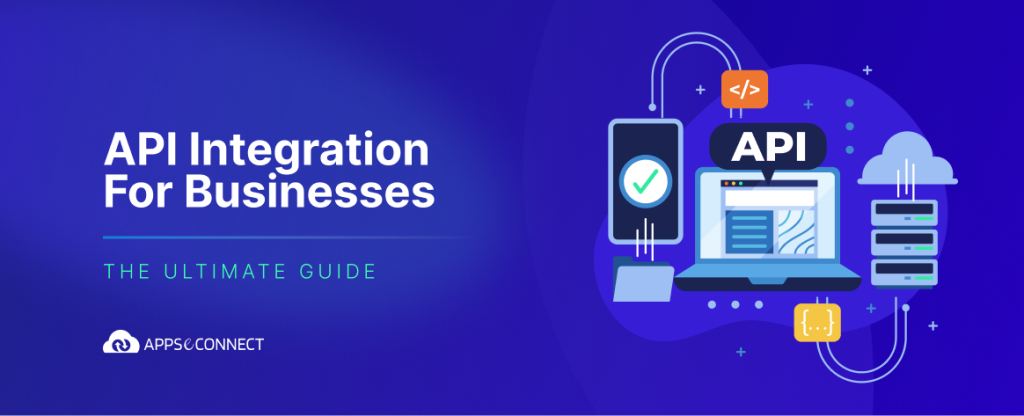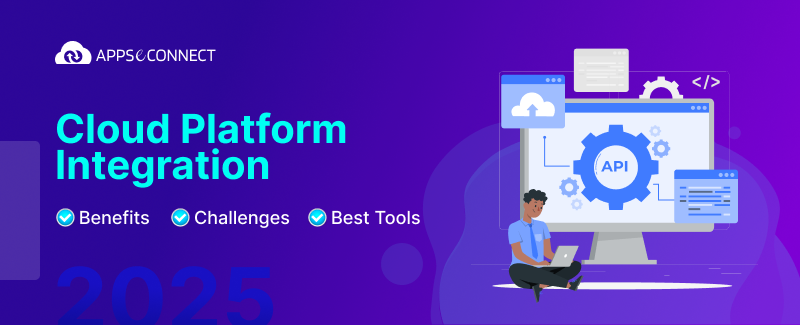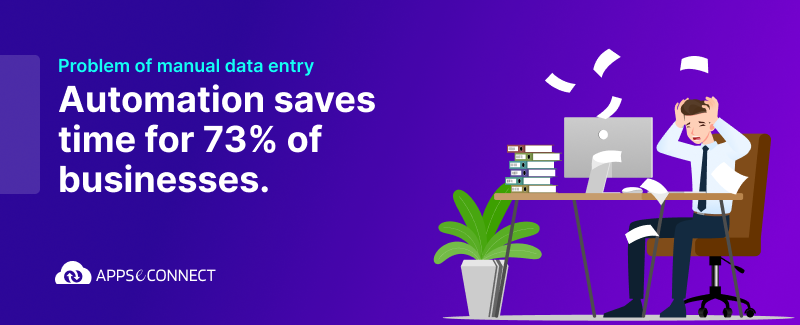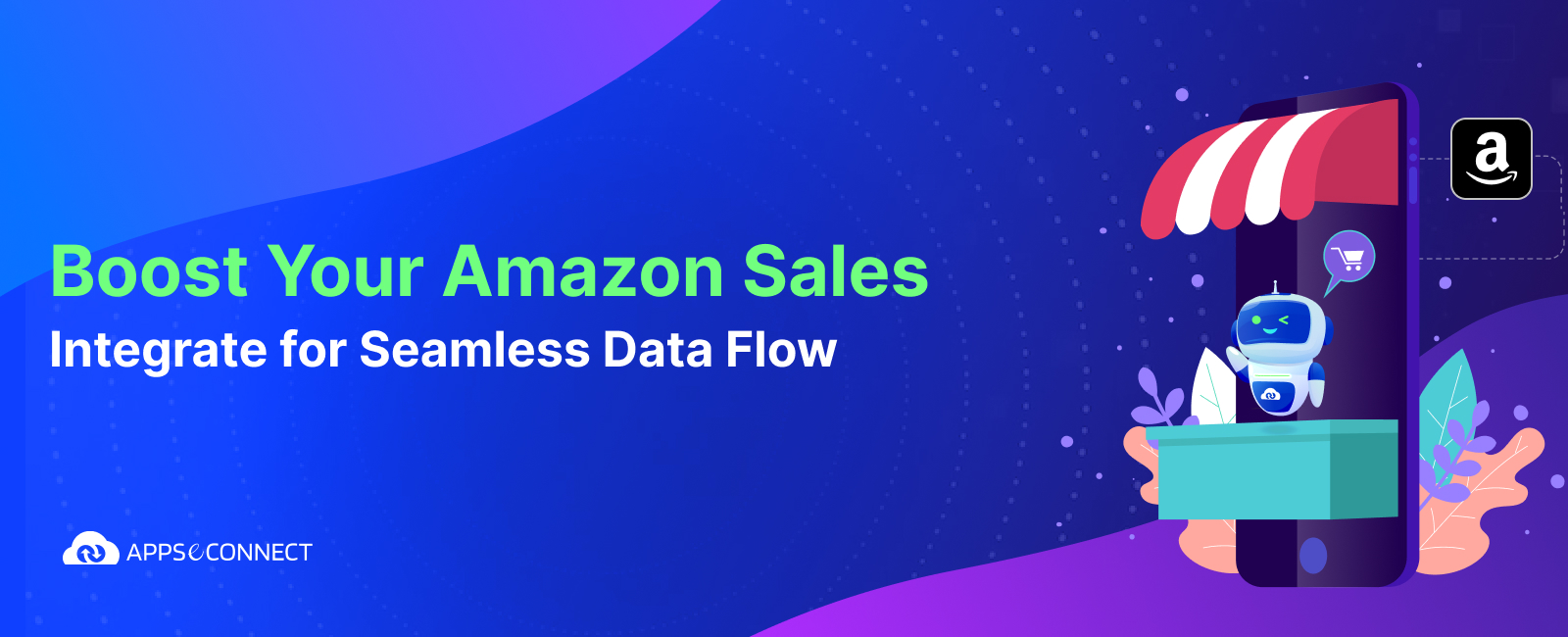APIs power the modern digital world—enabling eCommerce platforms to sync inventory in real time, CRMs to update customer data automatically, and different business applications to work together seamlessly. In short, API integration is what keeps today’s businesses connected and efficient.
But integrating APIs isn’t always simple. Should you build custom integrations from scratch or use a pre-built solution? How do you ensure security, scalability, and long-term reliability?
This guide answers such essential questions and breaks down everything you need to know about API integration. Whether you’re looking to streamline operations, improve efficiency, or scale your business, this resource will help you navigate API integration with clarity and confidence.
By the end of this guide, you’ll understand:
- The fundamentals of API integration and its role in digital transformation.
- The benefits and challenges of integrating your systems.
- When to build custom solutions versus using an integration platform.
- Real-world examples and future trends shaping API integration.
Let’s explore how API integration can streamline your operations and propel your business forward.
What is API integration?
API integration is the process of connecting different software applications through their Application Programming Interfaces (APIs) to enable seamless data exchange and coordinated functionality.
APIs are standardized sets of protocols and tools that allow disparate systems to interact without requiring developers to build custom connections for every interaction. In essence, they define the rules for how applications request and exchange data, making it easier for businesses to automate processes and integrate multiple systems.
For example, API integration can:
- Streamline ERP and eCommerce Operations: Automatically synchronize product data, inventory levels, and pricing between your ERP system (such as NetSuite) and an eCommerce platform (like Shopify), ensuring that all channels reflect up-to-date information.
- Automate CRM and Financial Processes: Connect a CRM (for instance, Salesforce) with accounting software (such as QuickBooks) so that customer transactions and financial records are updated in real time, reducing manual reconciliation.
- Enhance IoT Data Analytics: Enable real-time data flow from smart sensors to cloud-based analytics platforms, allowing organizations to monitor environmental or operational data and respond swiftly to trends or issues.
- Connect Payment and Accounting Systems: Automatically reconcile transactions by linking your payment processing system with your financial software.
How does API integration work?
At its core, API integration is about creating a seamless connection between two or more software applications so they can exchange data and perform functions without manual intervention.
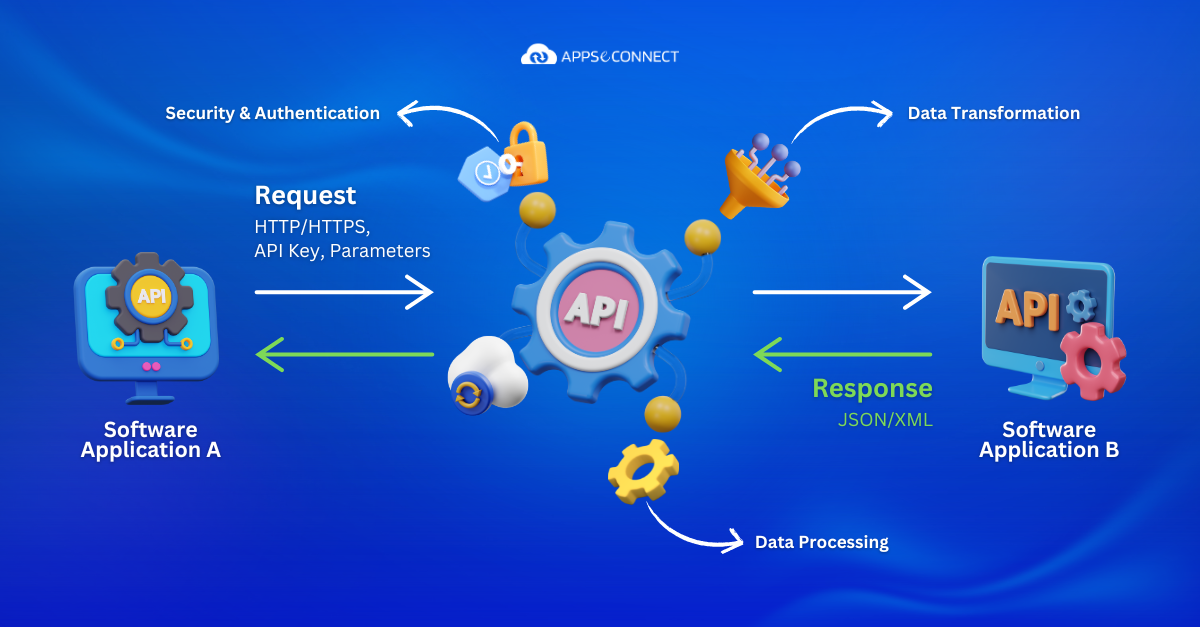
Here’s how the process typically works:
Establishing a connection
Each software application exposes its capabilities through an API—a set of defined rules and protocols. When one application needs to access data or functionality from another, it sends a request to the API endpoint provided by that system.
Request and response cycle
Request: The requesting application sends a structured message (often using standard protocols like HTTP/HTTPS) that specifies what information or action it needs. This request might include parameters, authentication tokens, and other necessary data.
Response: The target application processes the request and sends back a response in a standardized format (commonly JSON or XML). This response contains the requested data or a confirmation that the requested action has been performed.
Data exchange and transformation
In many cases, the data coming from one application might need to be transformed or mapped to match the format required by the receiving system. This step ensures that despite differences in data structures, the information is accurately interpreted and used by the connected applications.
Automation and orchestration
API integration isn’t just about single data exchanges—it can also involve complex workflows where multiple systems interact in sequence or parallel. Integration platforms (iPaaS) or middleware solutions can orchestrate these interactions, automating entire business processes such as order processing, invoicing, or customer data synchronization.
Security and monitoring
- Authentication and Authorization: Before any data is exchanged, secure protocols (like OAuth or API keys) ensure that only authorized applications can access the APIs.
- Error Handling and Monitoring: Built-in mechanisms detect issues (such as network failures or invalid requests) so that errors can be managed promptly, ensuring reliability and data integrity.
In Summary:
API integration works by having systems communicate through a standardized language. Applications send requests to each other, exchange data in agreed-upon formats, and leverage middleware or integration platforms to manage complex workflows—all while maintaining security and data integrity.
Types of APIs
APIs come in a variety of forms, each designed to serve distinct purposes and meet different business needs. By understanding these classifications, organizations can select the right API strategy to support their digital transformation and integration goals.
Based on accessibility
- Public APIs (Open APIs): These APIs are available to external developers and third parties. They foster innovation and allow businesses to build ecosystems around their services. Public APIs are ideal for companies looking to expand their reach or encourage third-party integrations.
- Private APIs: Restricted to internal use, private APIs enable seamless communication between an organization’s internal systems. They enhance operational efficiency and help maintain security and control over data exchanges.
- Partner APIs: These are shared with specific business partners under controlled conditions. Partner APIs facilitate strategic collaborations. Companies can integrate their services with trusted external partners while maintaining strict security and governance.
Based on architecture
- REST APIs: REST (Representational State Transfer) APIs use standard HTTP methods, making them lightweight, scalable, and easy to integrate. They’re widely adopted for their simplicity and flexibility, ideal for a broad range of business applications.
- SOAP APIs: SOAP (Simple Object Access Protocol) APIs rely on XML messaging and well-defined standards. Although more rigid, they offer robust security and transactional reliability, making them a strong choice in enterprise environments.
- GraphQL APIs: GraphQL provides a flexible query language that lets clients request exactly the data they need. This efficiency can reduce over-fetching and under-fetching of data, especially in applications with complex data requirements.
- gRPC APIs: Built on HTTP/2 and using Protocol Buffers for data serialization, gRPC APIs are optimized for high-performance, low-latency communication. They are well-suited for internal microservices and scenarios where speed is critical.
- WebSocket APIs: WebSocket APIs establish a full-duplex communication channel, enabling real-time data exchange. They are particularly useful for applications requiring live updates, such as financial tickers or real-time monitoring dashboards.
Based on communication patterns
- Synchronous APIs: In a synchronous model, the client sends a request and waits for an immediate response. This pattern is useful when real-time data consistency is critical for the business process.
- Asynchronous APIs: These APIs allow clients to send a request and continue with other tasks while the response is processed in the background. Asynchronous communication is ideal for handling long-running processes without impacting user experience.
- Streaming APIs: Streaming APIs provide a continuous flow of data, making them perfect for scenarios where real-time information is crucial—such as live event tracking or real-time eCommerce order sync to ERP systems.
Based on functionality
- System APIs: System APIs expose core systems (like ERP or CRM) for internal use. They ensure data consistency across backend systems and are foundational to maintaining operational continuity.
- Process APIs: Designed to orchestrate complex workflows, process APIs manage interactions across multiple systems. They simplify multi-step business processes, such as order fulfillment or invoicing, by streamlining the flow of data and tasks.
- Experience APIs: These APIs are tailored to deliver optimized data and functionality to end-user applications. By abstracting complex back-end processes, experience APIs help create seamless and personalized user experiences on web or mobile platforms.
Selecting the right API type is a critical step in your digital transformation journey. Understanding these different types of APIs helps you align your integration strategies with specific business requirements.
Types of API Integrations
When connecting systems, the architectural model has a significant impact on the flexibility, scalability, and ease of maintenance of your integration strategy. There are three primary types of API integrations based on connectivity models:
Direct (Point-to-Point) Integration
Direct integration establishes a direct connection between two systems. Each system communicates with the other’s API without any intermediary.
Key Characteristics:
- Simple Setup: Ideal for connecting a limited number of systems.
- Minimal Overhead: Fewer layers between applications can lead to faster communication.
- Maintenance Challenges: As the number of connections increases, the network of direct integrations can become complex and difficult to manage.
When to Use: Direct integration is best suited for straightforward use cases where only a few systems need to exchange data without complex orchestration.
Hub-and-Spoke Integration
In a hub-and-spoke model, a central hub acts as an intermediary that manages and routes data between multiple connected systems (the spokes).
Key characteristics:
- Centralized Management: The hub centralizes integration logic, making it easier to monitor and update connections.
- Scalability: New systems can be added to the hub without needing to establish separate direct links with every other system.
- Potential Bottlenecks: The central hub must be robust enough to handle the data flow from all spokes, as it can become a point of congestion if not scaled properly.
When to use: This approach is ideal for environments where multiple systems need to interact, and central oversight is crucial for managing data consistency and workflow orchestration.
Middleware-Based Integration (Enterprise Service Bus, ESB)
Middleware or an Enterprise Service Bus (ESB) serves as a dedicated integration layer that handles data transformation, routing, and orchestration between disparate systems.
Key Characteristics:
- Decoupling Systems: Middleware abstracts the integration logic, allowing systems to interact without knowing the details of each other’s implementations.
- Advanced Capabilities: Offers features like data transformation, protocol bridging, and centralized error handling.
- Complexity: While powerful, implementing an ESB can be more complex and may require a higher initial investment in both time and resources.
When to Use: Middleware-based integration is best for complex, large-scale environments where multiple systems require coordinated workflows, and where robust management of data flows, security, and error handling is a priority.
Benefits and use cases of API integration for businesses
When implemented effectively, API integration isn’t just a technical upgrade—it’s a strategic investment that delivers measurable business value. Here’s how robust API integration can drive real business outcomes:
Streamlined processes: API integration eliminates time-consuming manual tasks by automating data flows between systems. For example, a retail business that automatically synchronizes inventory data across its ERP and eCommerce platforms can reduce stock discrepancies and avoid costly overstock or stockout situations.
Unified data view: Integration creates a single source of truth by updating key metrics in real time, such as sales figures, supply chain performance, customer interactions. Executives gain instant access to accurate data, enabling more informed decisions and timely responses to market shifts.
Enhanced forecasting: Real-time insights support predictive analytics and forecasting. Businesses can anticipate demand trends, optimize inventory levels, and allocate resources effectively for fast growth.
Lower IT expenditure: Automating routine tasks reduces labor costs and minimizes human errors. Businesses can see significant savings in IT maintenance and operational overhead which also leads to stronger return on investment.
Faster time-to-market: Streamlined integrations mean that new services and products can be deployed more quickly. Accelerated launch cycles can lead to earlier revenue generation and a competitive edge in fast-moving markets.
Consistent omnichannel experience: API integration ensures that customers receive accurate, consistent information across all touchpoints—whether they’re browsing an online store, checking order status, or interacting with customer support. This consistency builds trust and enhances overall satisfaction.
Personalized customer engagement: By unifying data from various sources, businesses can tailor interactions and offers based on real-time customer behavior and preferences. Improved personalization leads to stronger customer relationships and higher retention rates.
Modernizing legacy systems: API integration bridges the gap between outdated legacy systems and modern, cloud-based applications. This hybrid approach enables businesses to modernize incrementally — leveraging existing investments while gradually adopting new technologies.
Future-proofing your technology stack: With an architecture that can integrate additional systems without major overhauls, companies can continuously evolve their technology stack while minimizing disruption and additional costs.
How to Implement API Integration: The Right Approach
There’s no one-size-fits-all solution when it comes to API integration. The optimal approach depends on your unique business requirements, available resources, and long-term goals. Broadly speaking, organizations typically choose between two paths: building custom integrations or leveraging ready-made solutions through an integration platform. Let’s explore each option.
Manual API Development (Custom Integration)
Custom integrations are designed specifically to fit your processes and workflows. You manage every aspect of data handling, error management, and performance tuning. It also gives you the flexibility to implement complex business rules and unique features that standard connectors may not support. Third party tools like Postman let you control and manage APIs exposed by different applications.
For example, did you know that you can upload files in Salesforce CRM using REST APIs through Postman. We’ve covered the steps to do this in another tutorial which you’ll find below.
Upload Files in Salesforce Using Rest API
Similarly, different APIs let you manage different functions and data requests between your applications.
In a CRM software, there can be APIs to fetch, update, or delete customer records, automate lead assignment, track sales progress, and update deal statuses, and more. In an email automation software, APIs allow you to automate email campaigns, schedule emails in advance, and track engagement metrics without manual intervention.
Most modern applications expose their APIs, and you can find their capabilities and usage details in their respective API documentation. For example, if you want to explore what APIs are available for Salesforce, a simple search for “Salesforce API documentation” will lead you to a comprehensive guide on the available endpoints, authentication methods, and integration possibilities.
Of course, understanding API documentation and effectively using these APIs requires technical expertise. If your organization has a team of API developers and integration experts, they can leverage API management tools to control and monitor API interactions between multiple applications. These tools help establish seamless automated communication and can even enable the creation of complex workflows that optimize business processes across different systems.
You should consider developing your own custom integrations if:
- Your business processes have unique requirements that off-the-shelf solutions can’t address.
- You possess in-house technical expertise capable of developing and maintaining integrations.
- You want full control over integration logic, data flows, and security is critical to your operations.
However, there are some downsides to manual development of API integrations. First of all, development will be time-consuming and resource intensive. Not to mention the continuous monitoring, updates, and troubleshooting, even after development, which may strain IT resources.
Custom-built solutions also face challenges when adapting to rapid growth or integrating additional systems. They may not be future-proof – changes or updates in the application’s architecture might require you to rebuild existing integrations.
Using API Integration Tools & Platforms (iPaaS Solutions)
iPaaS solutions offer a streamlined, cloud-based approach to connecting systems by providing pre-built connectors and low-code/no-code interfaces. This enables you to integrate multiple applications quickly and with less reliance on extensive custom development. Integration platforms usually have readymade connectors for popular applications and they allow you to build integrations with a low-code or no-code visual workflow builder.
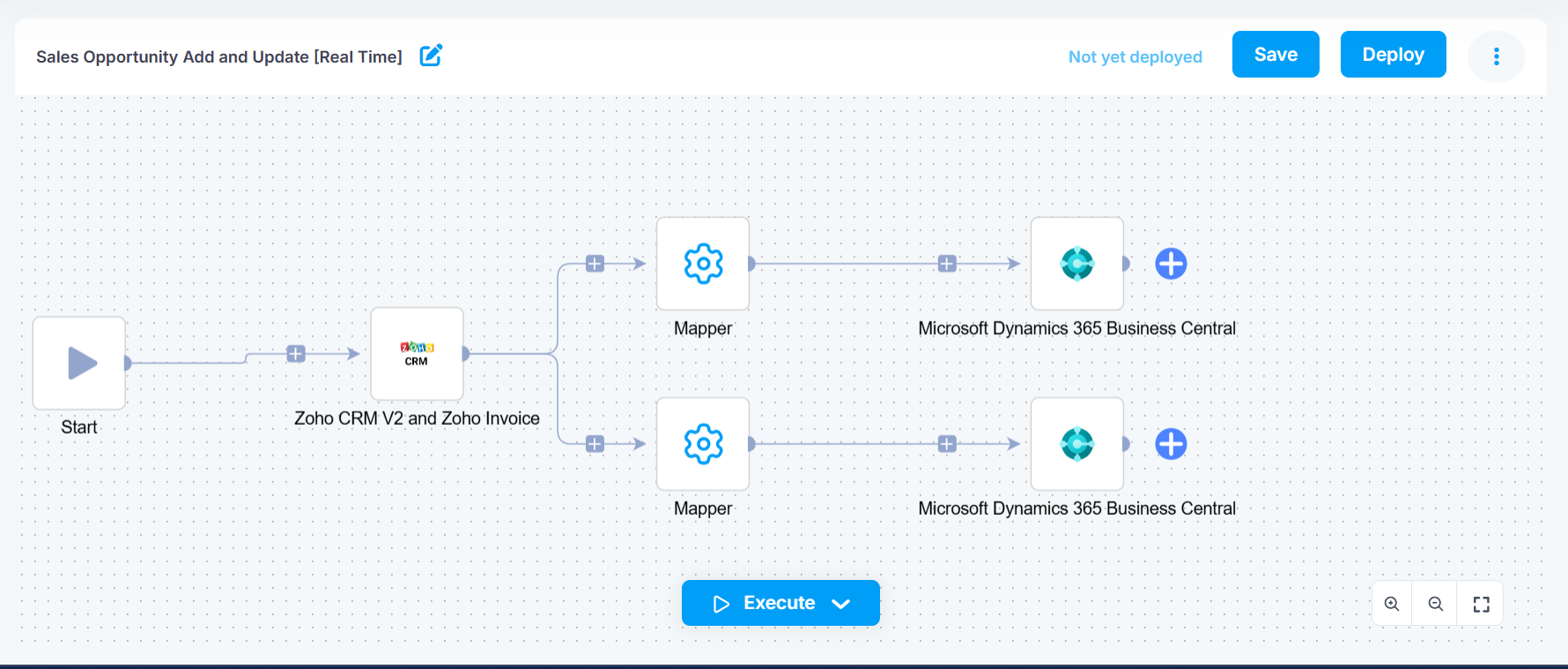
It allows businesses of all kinds to build integrations without technical expertise. iPaaS platforms come with a suite of pre-built connectors and low-code/no-code interfaces that enable swift deployment across multiple systems. With a vast range of iPaaS options tailored to different industries and business models, you can easily scale integrations as your organization grows.
You should consider an iPaaS solution if:
- You need to deploy integrations rapidly across several systems.
- You want to reduce the burden on your internal IT team by leveraging pre-configured connectors.
- Your business processes align with standard applications, making out-of-the-box integrations a practical fit.
The modern iPaaS ecosystem is diverse, with solutions designed to integrate with a wide range of systems — whether you’re working with ERP, CRM, eCommerce, or emerging technologies. There are platforms that offer powerful API management features, while others that come with easy visual workflow designers for API integrations.
You can choose to have as much control over the architecture and methods, while still enjoying the benefits of fast, pre-built integrations. This flexibility ensures that your integration strategy remains agile and adaptable to evolving business needs, eliminating the risk of vendor lock-in through a variety of available platforms.
Best Practices for Successful API Integration
Implementing API integration effectively requires a combination of strategic planning, robust security measures, and ongoing management. Here are some key best practices to ensure your integrations run smoothly and deliver business value:
- Define Objectives: Clearly outline your integration goals and KPIs.
- Prioritize Security: Use strong authentication (e.g., OAuth, API keys), encrypt data, and conduct regular audits.
- Design for Scalability: Build with future growth and additional integrations in mind.
- Ensure Data Quality: Implement automated monitoring and error handling to maintain consistency.
- Document Thoroughly: Keep detailed records of workflows, data mappings, and protocols.
- Test & Monitor Continuously: Regularly test integrations and use real-time monitoring to promptly address issues.
Real-World API Integration Case Studies & Success Stories
Explore how seamless API integration through APPSeCONNECT has transformed business operations. Here are four success stories that highlight distinct challenges and achievements:
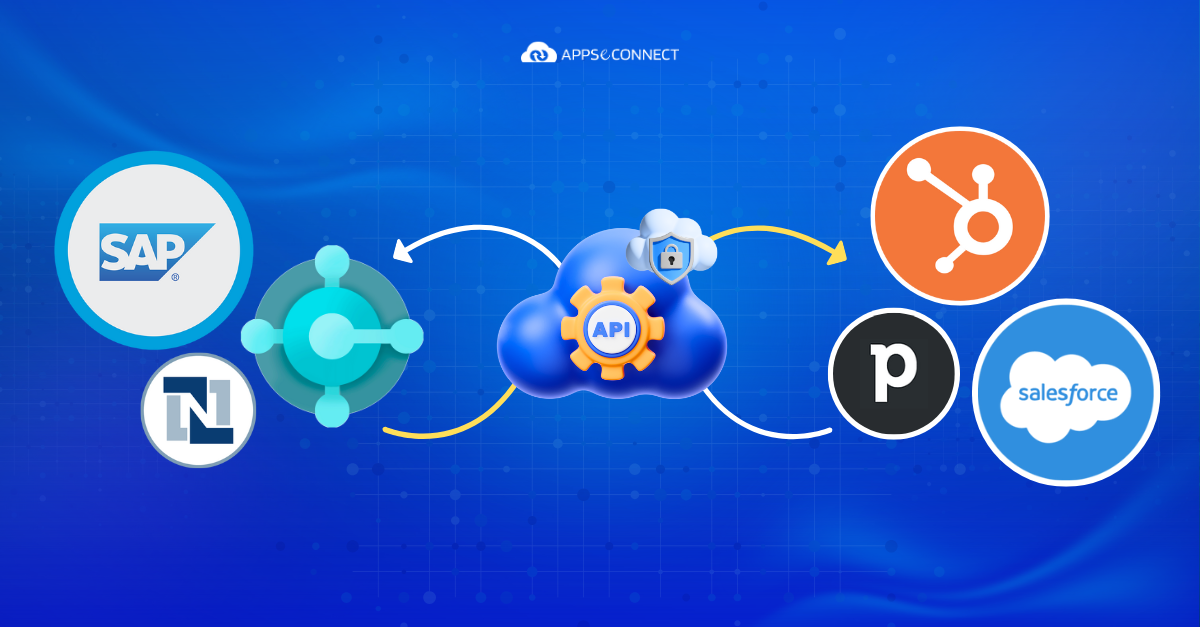
Ecommerce API Integration – Bernardo 1946
Bernardo 1946, a premium lifestyle brand, integrated their SAP backend with Shopify to streamline their ecommerce operations.
They sought to eliminate manual data reconciliation and ensure real-time inventory and order updates. By leveraging an iPaaS solution, they automated critical workflows, improved data accuracy, and delivered a more consistent customer experience.
Read the full case study of Bernardo 1946.
Retail ERP & Magento Integration – Nespresso
Nespresso, a global leader in premium coffee, connected Microsoft Dynamics AX with Magento to optimize their order management and inventory processes.
The integration aimed to bridge the gap between their robust ERP and dynamic online storefront, ensuring that critical business data was synchronized seamlessly. This strategic move enhanced operational efficiency and bolstered customer satisfaction.
Read the full case study of Nestle Nespresso.
Omnichannel Retail Integration – WTB
WTB, a dynamic retail brand, integrated Shopify Plus with SAP Business One to unify their sales channels and back-office operations.
Faced with the challenge of maintaining data consistency across platforms, they adopted an iPaaS solution to enable real-time synchronization of orders and inventory. The result was a significant reduction in manual errors and enhanced operational agility.
Read the full case study of WTB.
Multichannel Sales Integration – African American Expressions
African American Expressions, a retailer specializing in culturally inspired products, tackled the complexity of managing multiple sales channels by integrating their systems through an API integration platform.
Their goal was to reduce manual data entry and improve data accuracy across platforms. The successful integration provided a unified view of operations, driving efficiency and better decision-making.
Read the full case study of African American Expressions.
Future Trends in API Integration (What’s Next?)
API integration is evolving rapidly, driving new capabilities that empower businesses to be more agile and competitive. Key trends to watch include:
AI-Driven Automation
Artificial intelligence is beginning to play a pivotal role in API management. AI enables predictive error handling, intelligent scaling, and automated process optimizations that help businesses respond swiftly to shifting market demands.
Event-Driven Architectures
Moving away from traditional request-response models, event-driven architectures allow systems to process data in real time. This shift supports immediate reactions to business events and operational triggers, enhancing decision-making and operational responsiveness.
Microservices and Containerization
Breaking down complex applications into smaller, independent services allows for greater flexibility and scalability. Containerization technologies facilitate rapid deployment and updates, ensuring that integrations remain robust and resilient.
The Expanding API Economy
Open APIs are fueling new revenue streams and collaboration opportunities. As businesses tap into broader ecosystems, they can leverage third-party services to enhance their offerings and drive innovation.
Together, these trends promise to make API integration smarter, faster, and more secure—fueling ongoing digital transformation across industries.
Conclusion & Next Steps
API integration is a strategic enabler that transforms disjointed systems into a unified digital ecosystem—boosting efficiency, enhancing data accuracy, and driving innovation. As you refine your integration strategy, consider how seamless data flow can unlock new growth opportunities and simplify your operations.
Ready to take the next step? APPSeCONNECT offers a powerful, scalable iPaaS solution designed to streamline API integrations between ERP, CRM and eCommerce systems. Discover how our pre-built connectors and low-code tools can help you create a more agile and connected business environment through powerful API integrations.
Request a free trial or schedule a demo to explore the benefits of integrating your systems through APPSeCONNECT.


